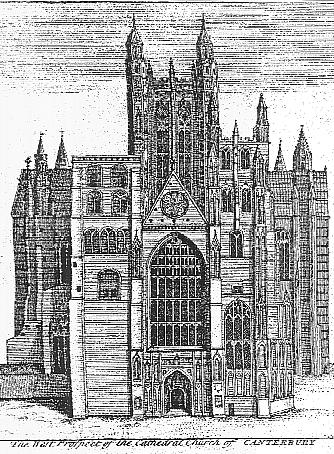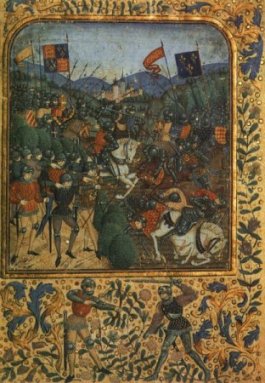
Canterbury Cathedral

 |
John Dunstable's Preco preheminenciae is an example of an isorhythmic motet. The motet is one of the more interesting genres of music in the Middle Ages. The musicologist, Hendrik van der Werf refers to it as follows: The motet is an odd member of the large family of medieval songs. It has two, three, or four voices, each of which usually has its own text. One of these voices actually is an excerpt from a Gregorian chant while the others are newly composed. The pre-existing voice, often called "cantus firmus" or "tenor", has the liturgical text, while the added voices sing texts specifically made up for the purpose. Much of the time, the tenor is the lowest sounding voice, and it often comprises a string of pitches for one syllable, whereas the upper voices have one syllable for almost every pitch they sing." Hendrik van dr Werf, The Chronology of Motet and Discant Passage and The Origin of Modal Notation (Armidale, Australia, 1995), 5. The isorhythmic motet, a subgenre of the family of motets, was often used for the most solemn or symbolic occasions. These motets, which were archaic practically from their inception, distinguish themselves by their complex rhythmic and melodic techniques, known as isorhythm, that served to assert order and structure to the composition. At its most basic level, isorhythm works as follows: the composer creates a rhythmic sequence and a melodic sequence - the two did not necessarily have to have the same number of elements - both of which are repeated throughout the composition. To this foundation, he freely composes other lines of music that complement or comment on the tenor or each other. For further and more complicated explanation of isorhythmic principles see the Sonic Glossary's entry on isorhythm. There is very little known of the life of the English composer John Dunstable (c.1380-1453); scholars even debate the proper spelling of his name: Dunstable or Dunstaple. From an inscription on hisgrave and records of the St. Alban's Abbey they have agreed that besides being an accomplished composer, he was also a mathematician and astronomer. Such multifaceted individuals were a logical extension of the education system of the time in which people were trained in the Seven Liberal Arts, which was comprised of the Trivium (grammar, rhetoric and logic) and the Quadrivium (arithmatic, geometry, music, and astronomy). In Dunstable's music the interplay of the four elements of the quadrivium is apparent as mathematics and proportion play an enormous importance in his music; his larger structure of his isorhythmic motets are balanced according to natural ratios. During Dunstable's lifetime, the Hundred Years' War raged and because of it, many English composers were present on the European continent serving in the retinues of the various Dukes pursuing military campaigns. Dunstable was in the service of John, Duke of Bedford, the brother of the famed Henry V, who fought the French armies of Joan of Arc. During the war there was a good deal of crossfertilization between the musical scenes and the sound of Dunstable's music, what came to be known as the contenance anglais, caused quite a sensation on the European continent, owing to its use of harmonies that were considered dissonant in Europe. Preco preheminenciae owes its genesis to the famed Battle of Agincourt, in which a tired and demoralized English army defeated the much stronger French army as a result of France's misguided decision to rely on cavalry and men-at-arms instead of archers. Shakespeare would later dramatise this battle brilliantly in Henry V from which the mother of all rallying speeches, Henry's St. Crispen's day speech comes. After England's surprise victory in the battle and the arrival of further good news with the breaking of the siege of Hartfleur by John of Bedford, a Mass of Thanksgiving attended by Henry V and The Holy Roman Emperor Sigismund was celebrated in Canterbury Cathedral. Preco preheminenciae was specially composed for this occasion in honor of Bedford and his patron saint, John the Baptist. The two best resources I have found for the Battle are here and here. |
|
John Dunstable: Preco prehemineciae/Precursor premititur/Internatus mulierum (ca. 1416)
|

|
|
A: Preco preheminenciae principi precessit, salus sapiencie subito successit; preco penitentiam prius predicavit, priceps per potentiam peccata purgavit; legislator latuit languidis largitus, precursor patuit prudens et peritus. Lympha lavit liquida lubricum luentum, truba tinctam turbida timet et tergentem; missus ministerium magni mandatoris mutat in mysterium modi melioris. Pax paterna panditur plebi penitenti, filius dum funditur flumine fluenti, descendit divinitus donum deitatis, oarticeps paraclitus, preiceps pietatis; singulare sequitur signum sanctitatis, tribus hiis tribuitur tronus trinitatis. Cessat circumfusio, cella celsitatis, renovat renacio requiem renatis; premebatur patria primitus penalis, renatosne regia recepit regalis. |
B: Precursur premititur populum parare, nebulosis nititur nova nunciare; deitatem domuit deserti decenter; predicando profuit pluribus predenter; carceris custodia captus coartatur, timens tantis talia tyrannus tubatur Crudeli convivio caro convocavit, saltans in salario sacro saciavit; pars prima precinditur proceris proceri miserando mittitur merces mulieri. Prestentper presidium preces precursoris, sequentis subsidium sancti salvatoris. |
C: Internatus mulierum non surrexit major Johanne ba[ptista] |
|
A: The herald preceded the supreme prince, the salvation of wisdom followed soon after; the herald proclaimed repentence beforehand; the prince purified us through his power; the lawgiver lay hidden, granted to the weak; the forerunner was manifest, wise and experienced. The flowing water washed the slippery path of expiation, the troubled crowd fears both the stain and the cleansing; he is sent and changes the ministry of a great messenger into a mystery of a better kind. The peace of the father is unfolded to his repentant people, while the Son is immersed in a flowing river. He descends from heaven, the gift of God, sharing with the consoler, the prince of piety. A single sign of holiness follows; to these three is assigned the throne of the Trinity. The outpouring ceases, the shrine of rebirth renews rest for the reborn. The land of punishment was for the first time subdued. The royal city takes back the reborn. |
B:
A vanguard is sent to prepare the people. He strives to announce the news to those in darkness; He fittingly overcame the god of the desert; by foretelling wisely he was of help to many. Captured, he was confined in the custody of prison. Fearing such things, the king was greatly ddisturbed. The body called together to a cruel banquet, dancing, in cursed payment, she wounded him by slicing off his head. The head was sliced off and sent as payment to the pittiable woman. The prayers of the vanguard stand forth as a help, the support of the holy saviour who follows. |
C: Born of woman there has never been one greater than John the Baptist. |